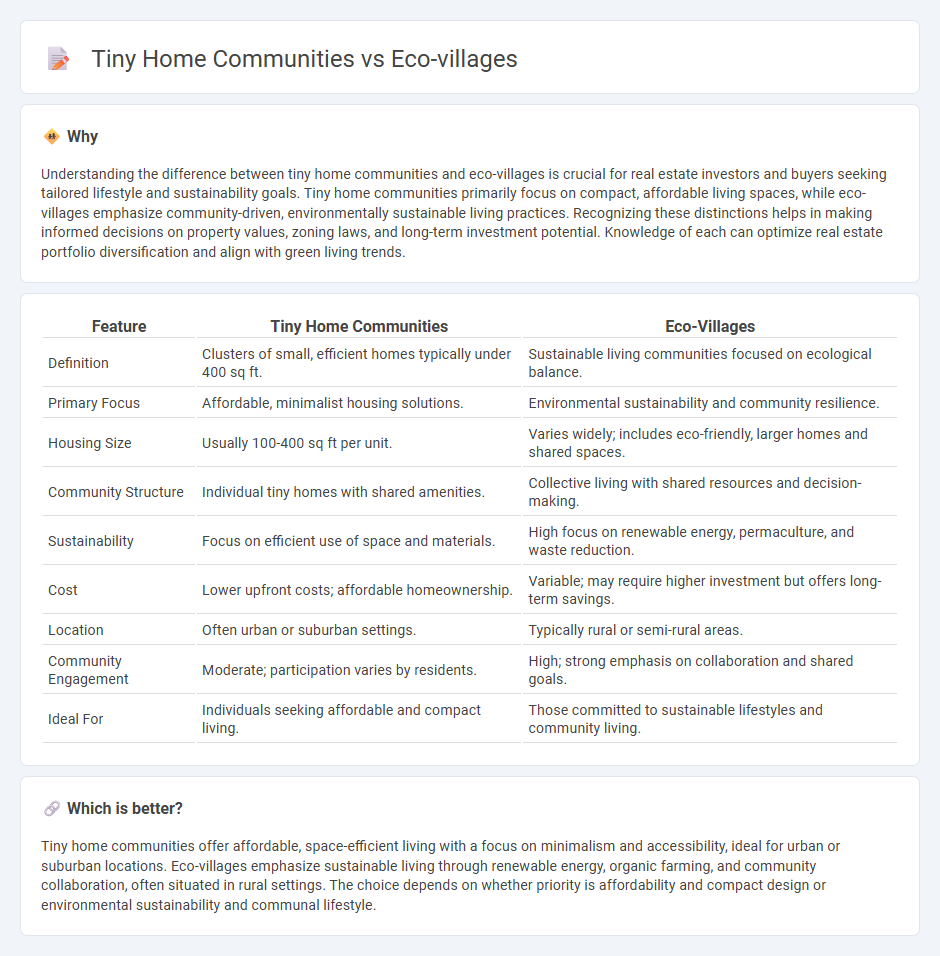
Tiny home communities offer compact, affordable living spaces designed for minimal environmental impact and efficient use of land. Eco-villages emphasize sustainable living through communal resources, renewable energy, and organic farming within intentional neighborhoods. Explore the distinct benefits and lifestyles of tiny home communities versus eco-villages to find which aligns with your real estate goals.
Why it is important
Understanding the difference between tiny home communities and eco-villages is crucial for real estate investors and buyers seeking tailored lifestyle and sustainability goals. Tiny home communities primarily focus on compact, affordable living spaces, while eco-villages emphasize community-driven, environmentally sustainable living practices. Recognizing these distinctions helps in making informed decisions on property values, zoning laws, and long-term investment potential. Knowledge of each can optimize real estate portfolio diversification and align with green living trends.
Comparison Table
| Feature | Tiny Home Communities | Eco-Villages |
|---|---|---|
| Definition | Clusters of small, efficient homes typically under 400 sq ft. | Sustainable living communities focused on ecological balance. |
| Primary Focus | Affordable, minimalist housing solutions. | Environmental sustainability and community resilience. |
| Housing Size | Usually 100-400 sq ft per unit. | Varies widely; includes eco-friendly, larger homes and shared spaces. |
| Community Structure | Individual tiny homes with shared amenities. | Collective living with shared resources and decision-making. |
| Sustainability | Focus on efficient use of space and materials. | High focus on renewable energy, permaculture, and waste reduction. |
| Cost | Lower upfront costs; affordable homeownership. | Variable; may require higher investment but offers long-term savings. |
| Location | Often urban or suburban settings. | Typically rural or semi-rural areas. |
| Community Engagement | Moderate; participation varies by residents. | High; strong emphasis on collaboration and shared goals. |
| Ideal For | Individuals seeking affordable and compact living. | Those committed to sustainable lifestyles and community living. |
Which is better?
Tiny home communities offer affordable, space-efficient living with a focus on minimalism and accessibility, ideal for urban or suburban locations. Eco-villages emphasize sustainable living through renewable energy, organic farming, and community collaboration, often situated in rural settings. The choice depends on whether priority is affordability and compact design or environmental sustainability and communal lifestyle.
Connection
Tiny home communities and eco-villages share a strong connection through their focus on sustainable living, minimal environmental impact, and efficient use of space. Both concepts emphasize community-oriented lifestyles, incorporating shared resources and green technologies such as solar power and rainwater harvesting to reduce carbon footprints. These developments promote affordability and resilience, appealing to individuals seeking eco-friendly real estate alternatives that align with conscious consumption and land stewardship.
Key Terms
Sustainability
Eco-villages integrate renewable energy systems, permaculture agriculture, and waste recycling to minimize environmental impact, fostering collective stewardship of natural resources. Tiny home communities prioritize sustainable land use through compact living spaces and reduced resource consumption, promoting affordability and lower carbon footprints. Explore the unique sustainability practices that define eco-villages and tiny home communities to better understand their environmental benefits.
Zoning Regulations
Zoning regulations for eco-villages often require compliance with community land use plans promoting sustainability, renewable energy, and shared resources, while tiny home communities face challenges related to minimum dwelling sizes, density limits, and utility connections. Eco-villages may be zoned under agricultural or rural designations allowing for diverse environmental practices, whereas tiny home communities frequently seek variances or special permits to accommodate non-traditional housing. Explore detailed case studies and legal frameworks to understand how zoning shapes the development of these innovative living models.
Community Governance
Eco-villages emphasize collective decision-making through consensus or sociocracy, fostering strong community governance and shared responsibilities. Tiny home communities often utilize homeowners' associations or cooperative models to manage common spaces and enforce rules. Discover how these governance structures impact sustainability and resident engagement by exploring their unique approaches.
Source and External Links
Ecovillages From Around the World for Sustainable Living - Ecovillages are intentional or traditional communities aiming for social, cultural, ecological, and economic sustainability using local participation, often combining traditional wisdom with innovation to minimize environmental impact.
Ecovillage - These communities emphasize sustainability through renewable energy, waste reduction, organic farming, green building, and fostering social cohesion via collaborative decision-making and shared responsibilities.
5 of the World's Coolest EcoVillages - Findhorn EcoVillage in Scotland exemplifies ecovillage ideals with low ecological footprint, sustainable architecture, renewable energy, and educational programs promoting sustainability and community resilience.
 dowidth.com
dowidth.com